Author: RootData Research
Key Points
- In the first half of 2025, the total amount of financing in the primary crypto market was US$7.75 billion, a year-on-year increase of 40.17% and a month-on-month increase of 77.75%. There were 547 financing events, with an average of 91 per month, and the number continued to decline. The overall trend showed that large financing was concentrated, mergers and acquisitions were active, track preferences turned to CeFi, and funds flowed to the secondary market. The market value of stablecoins exceeded US$240 billion, and the rise in linkage with BTC provided liquidity support for primary financing, especially promoting large transactions in the CeFi field.
- The primary crypto market shows the coexistence of capital concentration and track diversification. CeFi dominates the market due to its liquidity support and compliance advantages, while DeFi and tool tracks continue to be favored due to technological innovation. From the 399 financings with disclosed amounts, the number of financings below US$10 million dropped by more than 45% year-on-year, nearly halving; the number of financings above US$50 million surged by 146.7% , mainly concentrated in CeFi, mining companies and asset management companies.
- Hot money in the market is moving towards U.S. stock concepts. In the first half of the year, the top four rounds of financing with the highest amount were contracted by institutional activities (M&A/Pre-IPO/IPO/private placement) , which significantly exceeded the seed to A rounds of financing that were previously favored by crypto venture capital and intensively appeared in the DeFi and infrastructure fields.
- Ethereum's total financing reached $1.63 billion, ranking first among public chains, but emerging public chains have significantly surpassed Ethereum in terms of application growth rate. Monthly active developers fell to about 21,800 in January, a nearly four-year low, and rebounded to a high of 29,700 in the middle of the year. Community-driven technological innovation is filling the financing gap.
- Binance Alpha has made BNB Chain a CEX-DEX test field, and its DEX trading volume has jumped from 12% to 49% of the entire network. The Alpha points system sets different scores and tiered thresholds as a governance weight allocation mechanism for the Binance and BNB ecosystem, and has successfully explored new paths for Binance Listing and VC exit. Binance Alpha has 56.5% of unannounced financing projects, and the total market value of unannounced financing projects is as high as US$8.69 billion, while the total market value of projects that have received financing is only US$6.23 billion. Less than 25% of projects have a financing valuation history and excellent performance.
- Circle, a Wall Street money-making beast, became the project with the highest IPO financing amount with $2.2 billion. Before the IPO, Circle SPV had sold OTC shares at $36 per share (valued at $8.2 billion). In contrast, Coinbase and Kraken only raised $500 million and $120 million respectively, and their large-scale financing in the US stock market took about 1-2 years. The recognition of the stablecoin and RWA fields by Wall Street has injected strong momentum into the mainstream process of the entire industry.
In the first half of 2025, a total of 547 crypto primary market financings were recorded, totaling US$7.75 billion
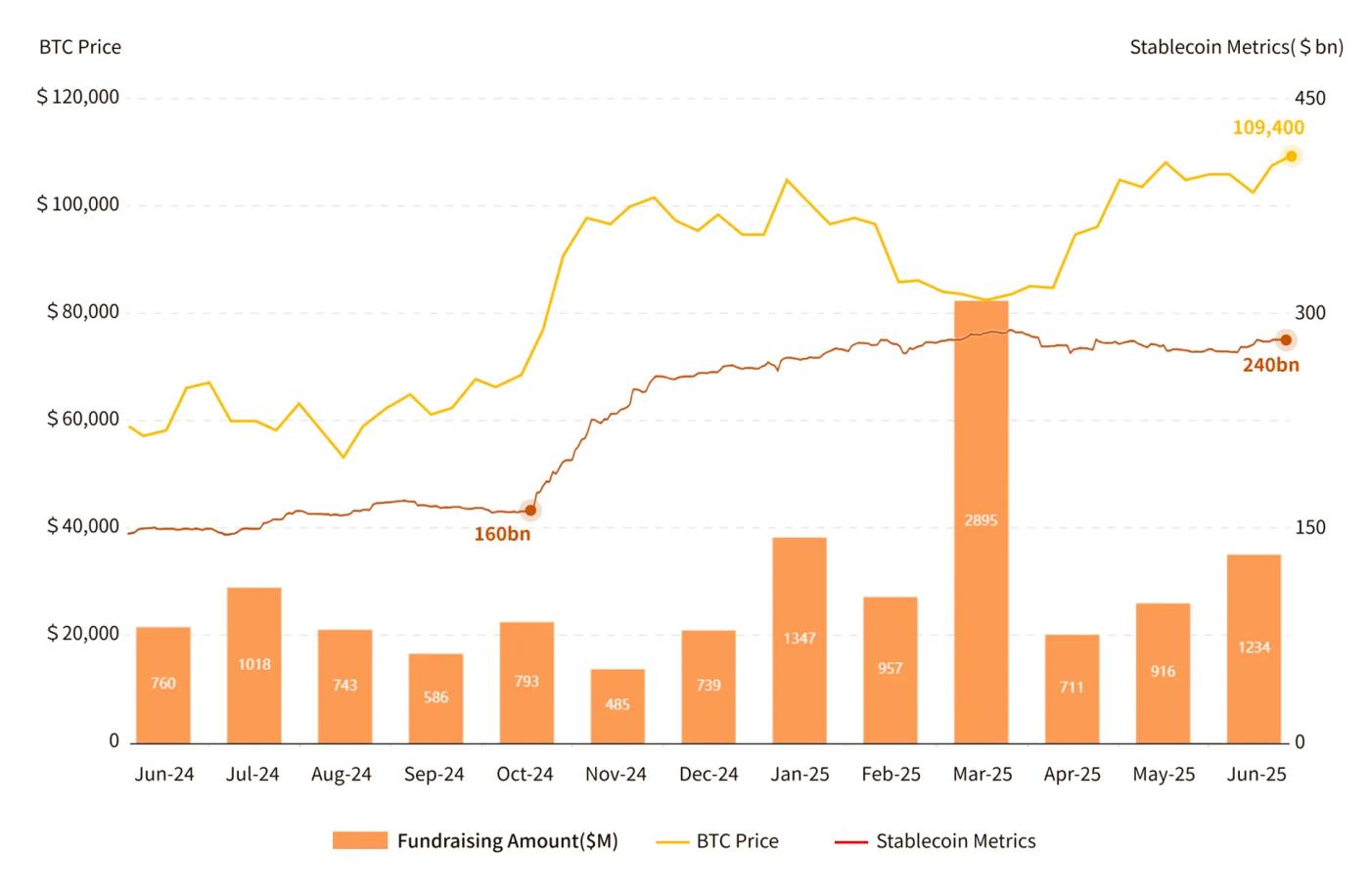
Web3 primary market financing, BTC price, and the correlation of stablecoins
In the first half of 2025, the amount of financing in the primary crypto financing market reached 7.75 billion US dollars, a year-on-year increase of 40.17% and a month-on-month increase of 77.75%. In March, 2.895 billion US dollars were raised, of which Binance accounted for 2 billion US dollars. Excluding this financing, the average monthly financing was about 950 million US dollars, the average financing amount was 12.419 million US dollars, and the median was 5.425 million US dollars.
There were 547 financing events, an average of 91 per month, and first-time project financing accounted for 57.7% (316 events). In terms of track distribution, CeFi led with a financing amount of US$2.719 billion, surpassing the infrastructure track (US$1.87 billion). M&A activities increased significantly to 66, an increase of 60.9% from 41 in the second half of 2024. Crypto-related listed companies (such as Circle and Sol Strategies) raised US$2.233 billion, a record high.
The stablecoin market has expanded significantly since the end of October 2024, with the total market value rapidly increasing from $160 billion to $240 billion, a 50% increase. During the same period, the price of BTC climbed from a low of $68,000 to $105,000, and has not fallen back to the range before the stablecoin rally this year. The coordinated rise of stablecoins and BTC has provided liquidity support for primary financing, especially promoting large transactions in the CeFi field.
Overall, the amount of financing in the primary crypto market increased significantly in the first half of 2025, but the number of events continued to decline, showing a trend of concentrated large-scale financing, active mergers and acquisitions, a shift in track preference to CeFi, and funds flowing to the secondary market.
Investment hotspots tend to be compliance, diversification and scale
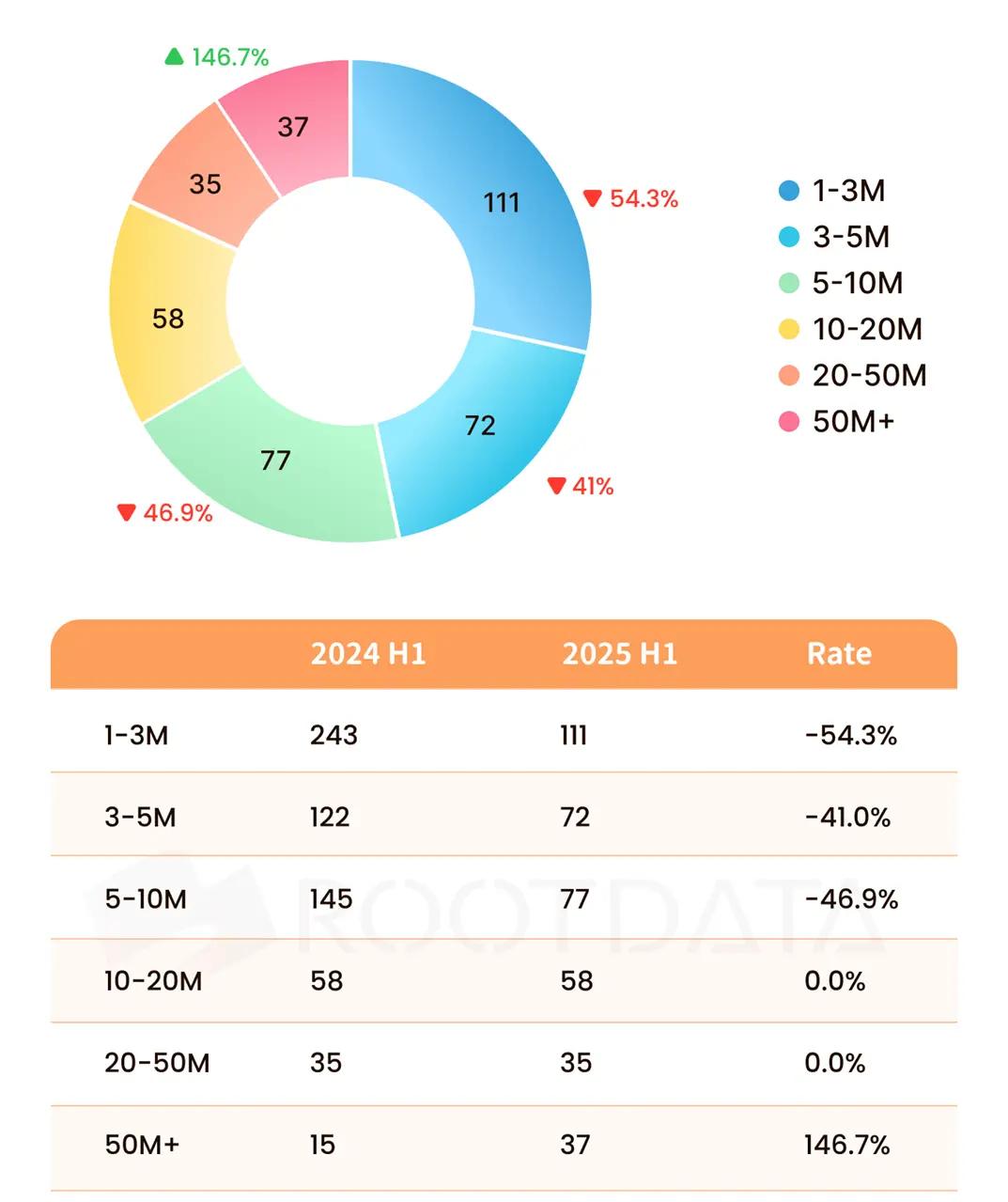
Overview of Financing Amount Distribution in the First Half of 2025
From the 399 financings with disclosed amounts, the number of financings below US$10 million dropped by more than 45% year-on-year, nearly halving; the number in the US$10-50 million range remained stable; the number of financings above US$50 million surged by 146.7%, mainly concentrated in CeFi, mining companies and asset management companies , indicating that capital prefers large investments and reduces small investments.
The performance of the track is clearly differentiated, and investment hotspots tend to be compliant and diversified. CeFi led the way with a financing amount of US$2.719 billion, a surge of 479.7% year-on-year and 1354% month-on-month, regaining its leading position. The infrastructure track raised US$1.87 billion, a decrease of 17.1% month-on-month. The DeFi and tool tracks attracted funds up 84.1% and 117.9% year-on-year respectively.
In the first half of 2025, the primary crypto market showed the coexistence of capital concentration and track diversification. CeFi dominated the market trend due to its liquidity support and compliance advantages . Listed companies followed Strategy's crypto reserve strategy and reshaped the valuation logic with the help of BTC and stablecoins' liquidity and value-added potential; DeFi and tool tracks continued to gain favor due to technological innovation , and the overall market moved towards a more efficient investment structure.
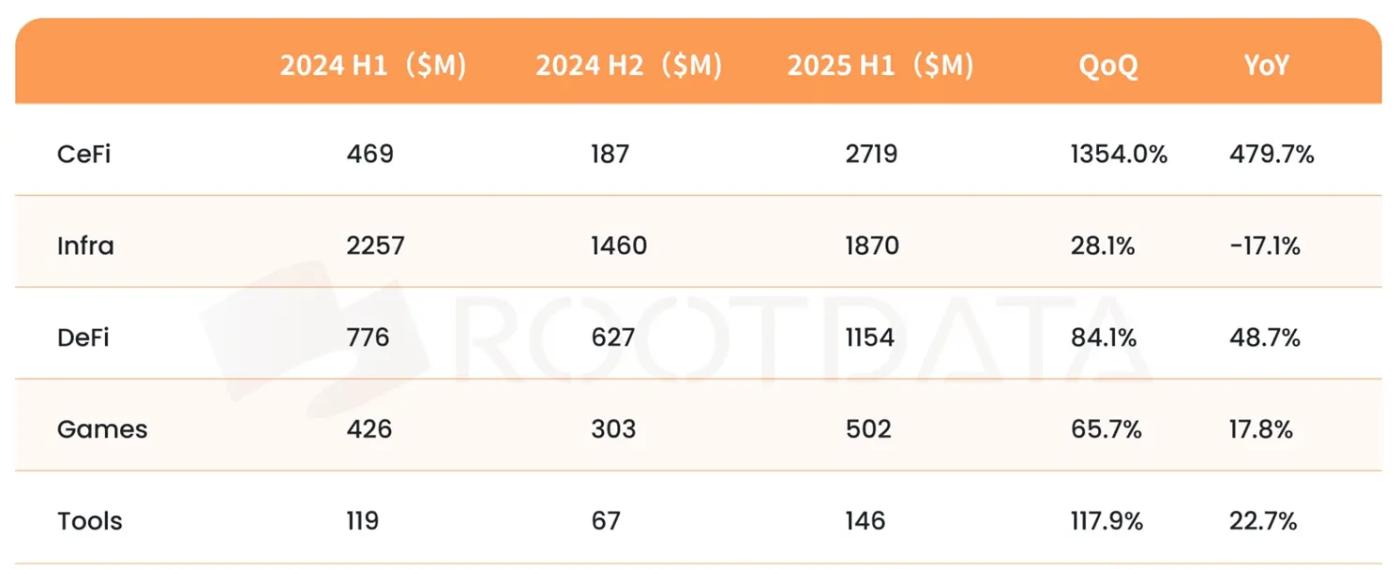
Top 5 Financing Tracks in the First Half of 2025
A16z and Coinbase Ventures Lead Crypto Investment in the First Half of 2025
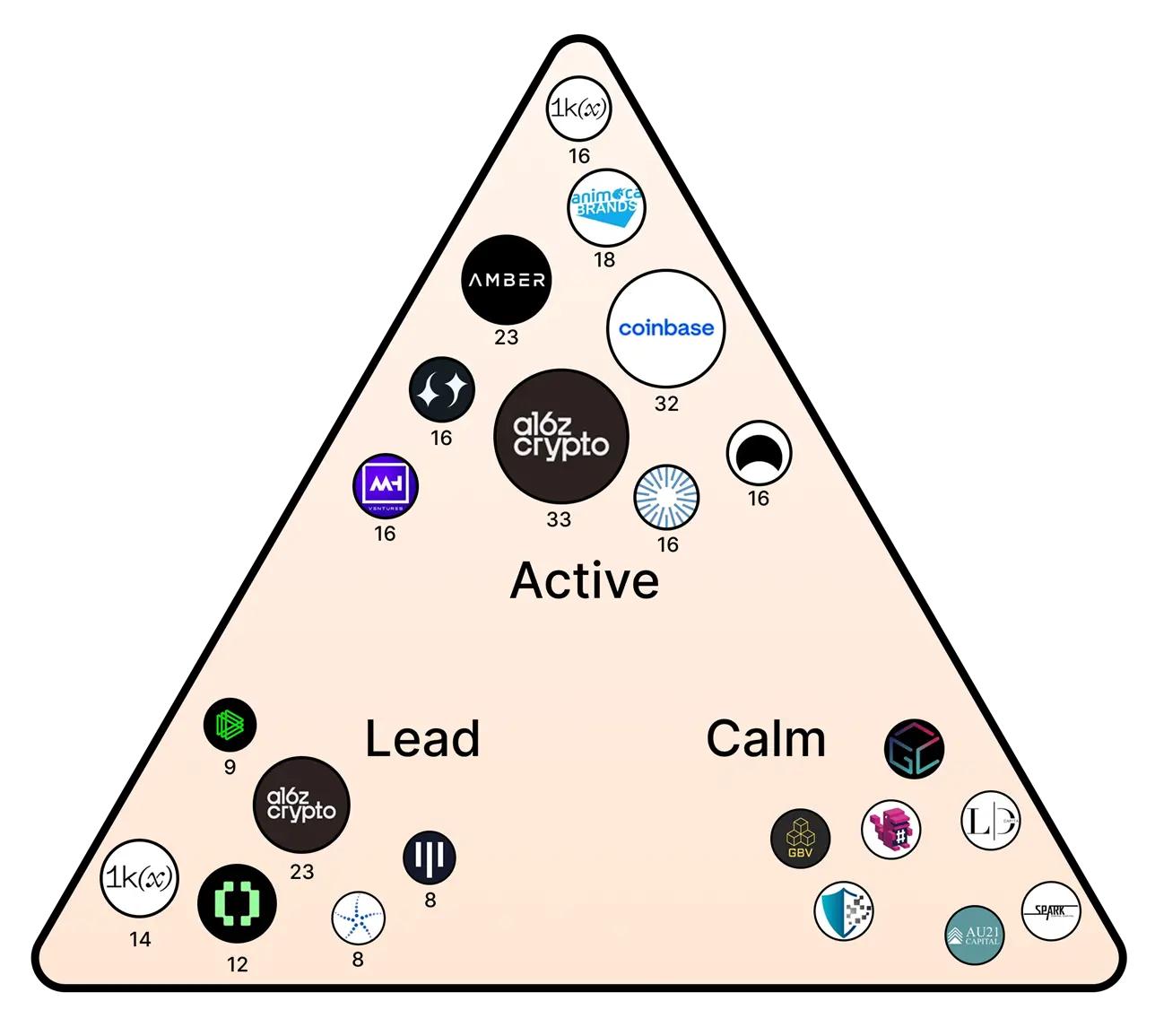
2025 H1 Crypto Native Institutional Performance
a16z and Coinbase Ventures led the crypto investment in the first half of 2025. a16z invested 33 times and led 23 of them. Its investment focused on the intersection of AI and blockchain, showing a precise layout. Coinbase Ventures followed closely with 32 investments, but only led 2 of them, adopting a diversified strategy of casting a wide net. 1kx, Hack VC, and Paradigm maintained their leading position in leading investments, each with its own characteristics .
Crypto-native funds tend to be conservative in their investments. 700 institutions that have invested at least once (even institutions such as LD Capital and AU21 Capital that have invested more than 200 times cumulatively) did not invest in the first half of the year, accounting for about 67%, reflecting the cautious sentiment of the market . Inspired by listed company Strategy, some crypto VCs have turned to investing in blockchain concept stocks , promoting the further integration of crypto assets and traditional finance, reflecting the diversification and maturity of crypto investment strategies.
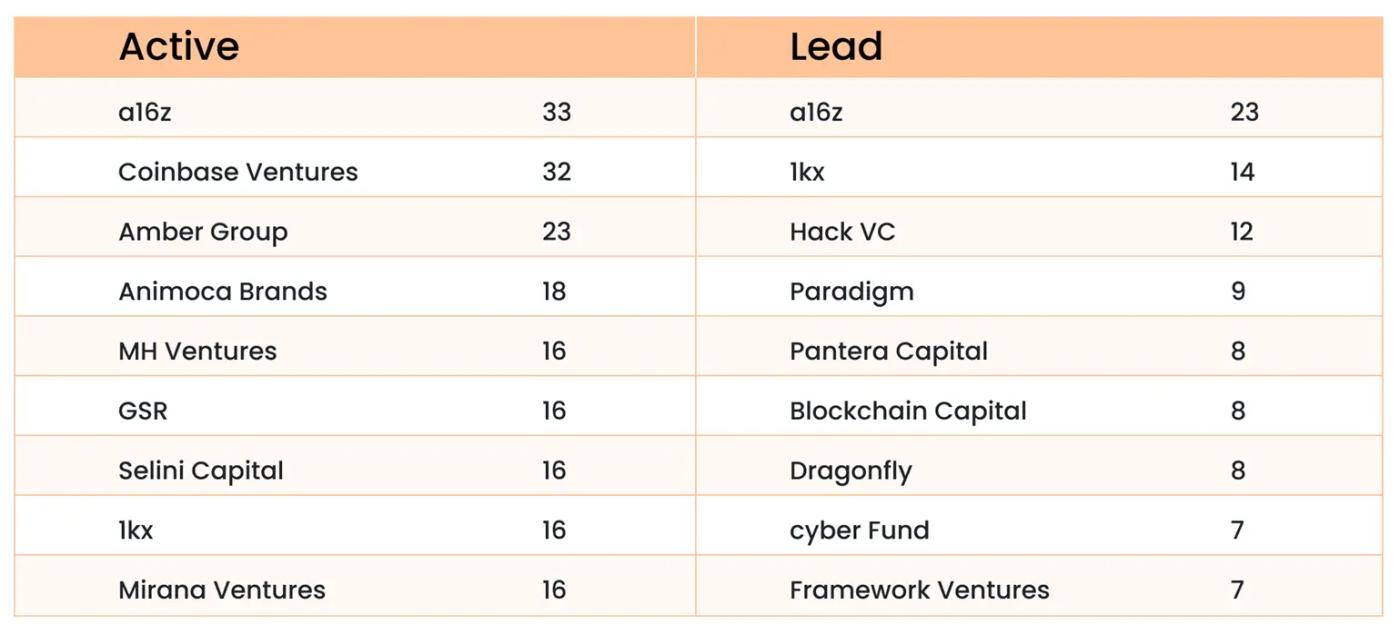
The fragmentation of the public chain ecosystem has intensified, and the driving force of crypto funds on public chains and applications has weakened
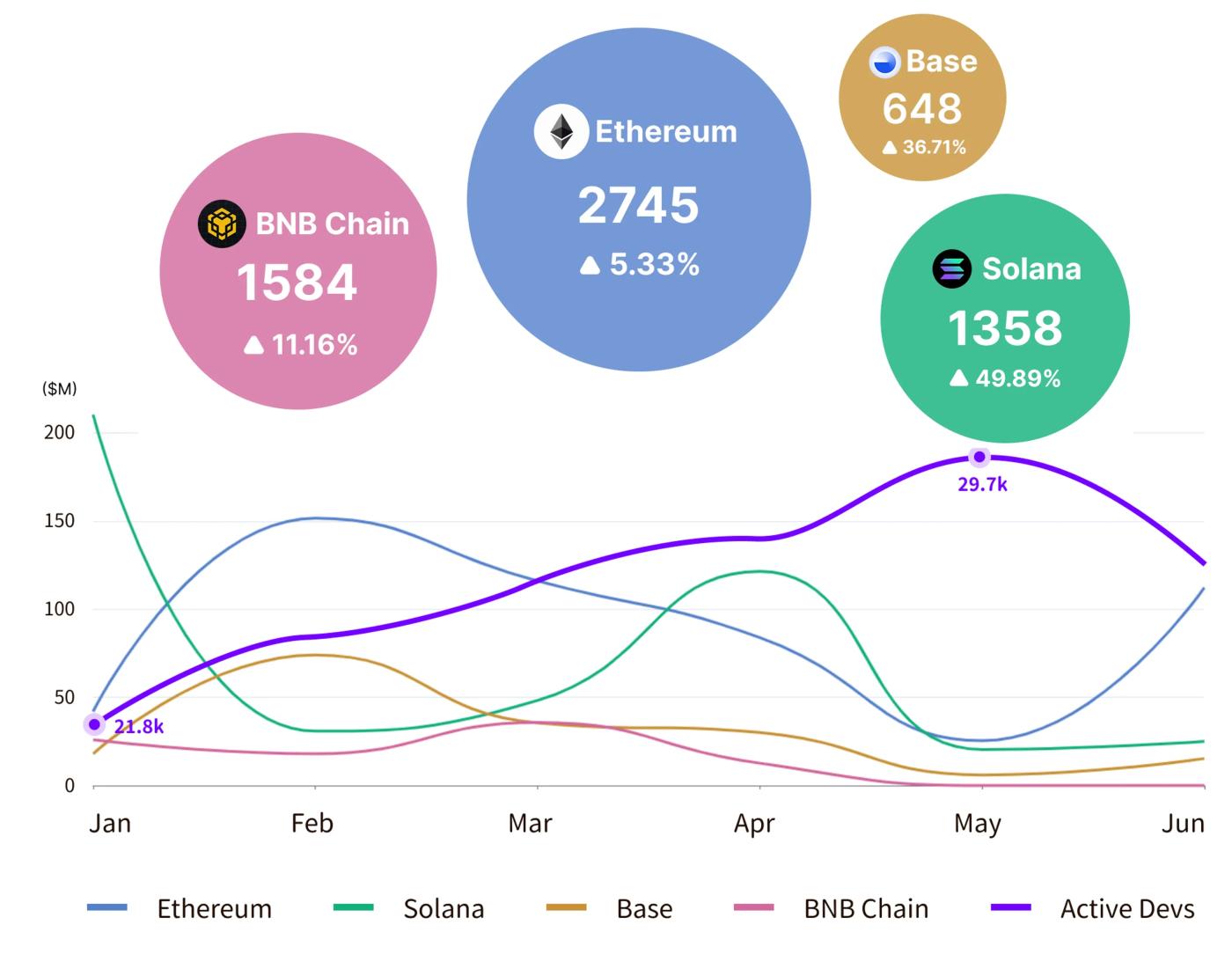
2025 H1 Mainstream public chain ecology and financing performance
Ethereum remains the leading public chain with over 2,700 high-quality applications (excluding unknown meme projects), with a total financing amount of US$1.63 billion, far exceeding other ecosystems, consolidating its market dominance.
However, emerging public chains meet the diverse needs of users by optimizing specific dimensions of the “Blockchain Trilemma”. Emerging public chains significantly surpass Ethereum in terms of application growth rate, quickly seize market segments , and challenge its dominance. This ultimately leads to the intensification of public chain ecosystem fragmentation.
For example, Solana has become a hotbed for Meme coins and DeFi applications with its high throughput, attracting high-frequency trading users. Base focuses on compliant assets and AI-driven on-chain applications, optimizing low-cost Layer 2 solutions to meet the needs of institutions and developers.
Crypto funds have weakened their driving force on public chains and applications, and the amount of financing has significantly deviated from the growth of the application ecosystem. In the first half of the year, primary market funds were concentrated on the CeFi track. The financing amount of mainstream public chains was generally sluggish and showed a downward trend, but application development was not significantly affected. According to developerreport data, monthly active developers fell to about 21,800 in January this year, a nearly 4-year low, and rebounded to a high of 29,700 in the middle of the year. Community-driven technological innovation is filling the financing gap.
Binance Alpha turns BNB Chain into a CEX-DEX test field
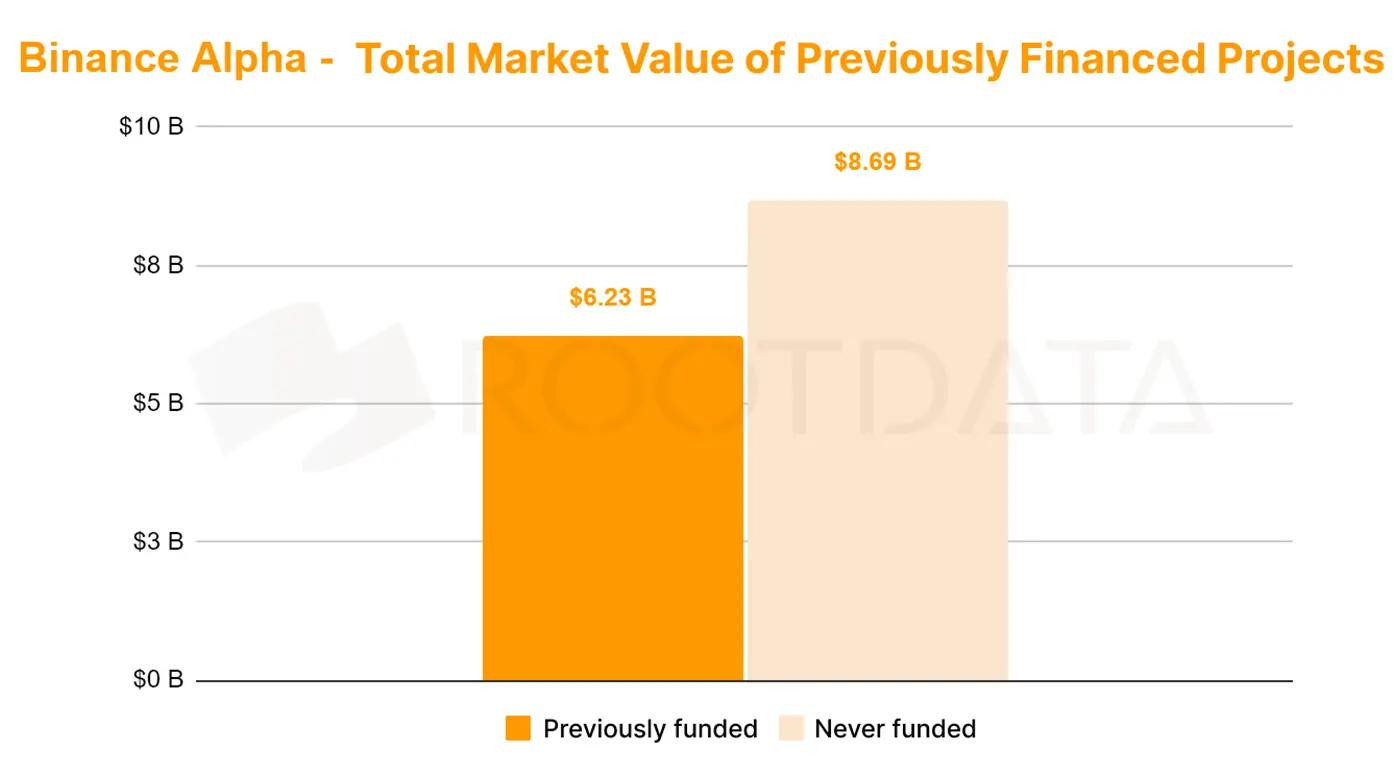
The most eye-catching phenomenon in Q2 2025 is undoubtedly the $1.7 million Binance Alpha project launched by Binance in May. Compared with the BTC Renaissance CEX-DEX trading experience pioneered by OKX, the controversial Binance Listing and VC exit path, or the covetousness of the lucrative DEX and All-in-one (AIO) on-chain trading platforms.
The Binance Alpha project aims to provide liquidity to project parties while creating a prosperous on-chain interactive scenario for the BNB Chain, guiding and incentivizing users to migrate liquidity from CEX to its own ecosystem.
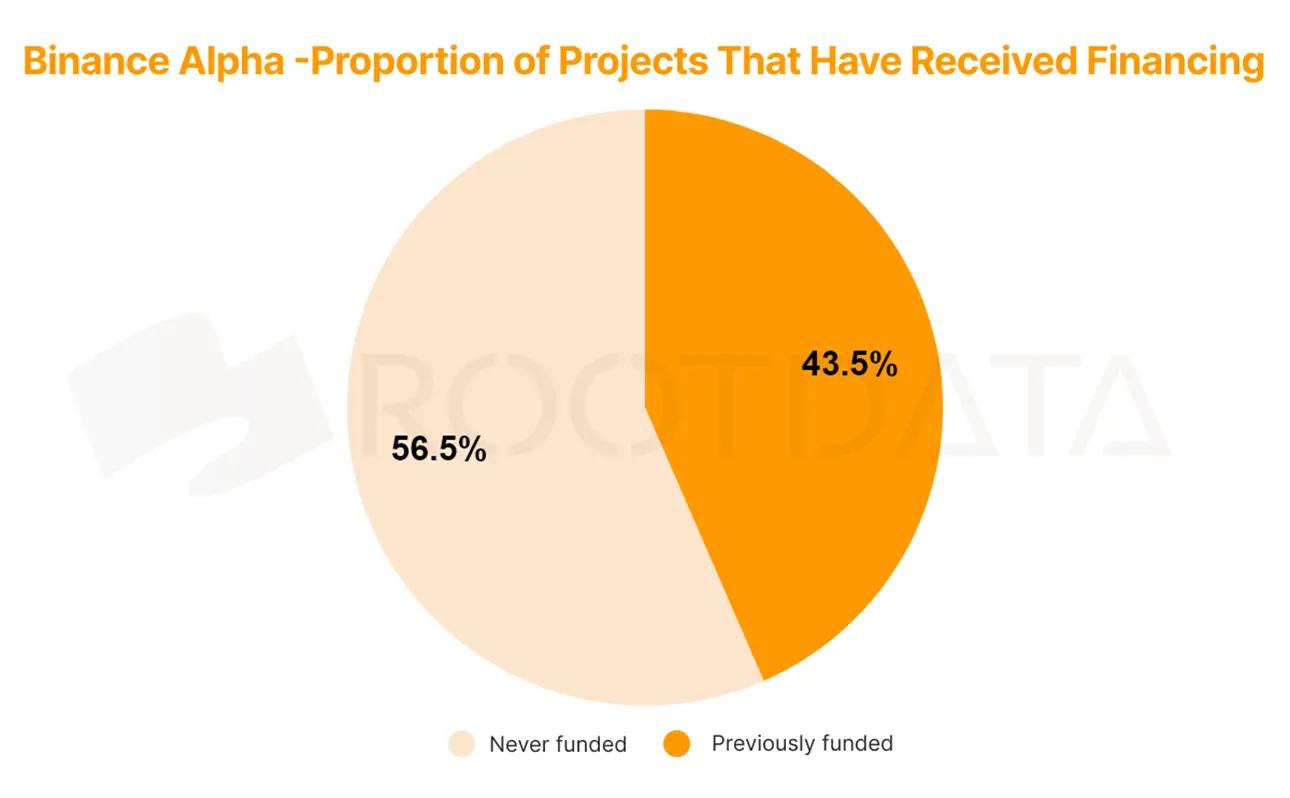
Market data verifies the effectiveness of this strategy : from April to July, BNB Chain’s DEX daily trading volume surged from US$1 billion to a peak of US$7 billion, and its share of total network trading volume jumped from 12% to 49%, while Ethereum and Solana’s shares fell from 25% and 22% to 15% and 11%, respectively.
Subsequently, other T2 exchanges also launched their own unique centralized DEX trading experience services. This move by Binance is not only an incentive for users, but also marks that 2025 will be the first year for centralized exchanges to transform and compromise with the original crypto ecosystem . The Alpha points system aims to strengthen the stickiness of Binance users and the community by setting different scores and tiered thresholds, and will serve as a governance weight distribution mechanism for the Binance and BNB ecosystem.
Institutional endorsement is in a dilemma, and the logic of new coin listing is driven by the community
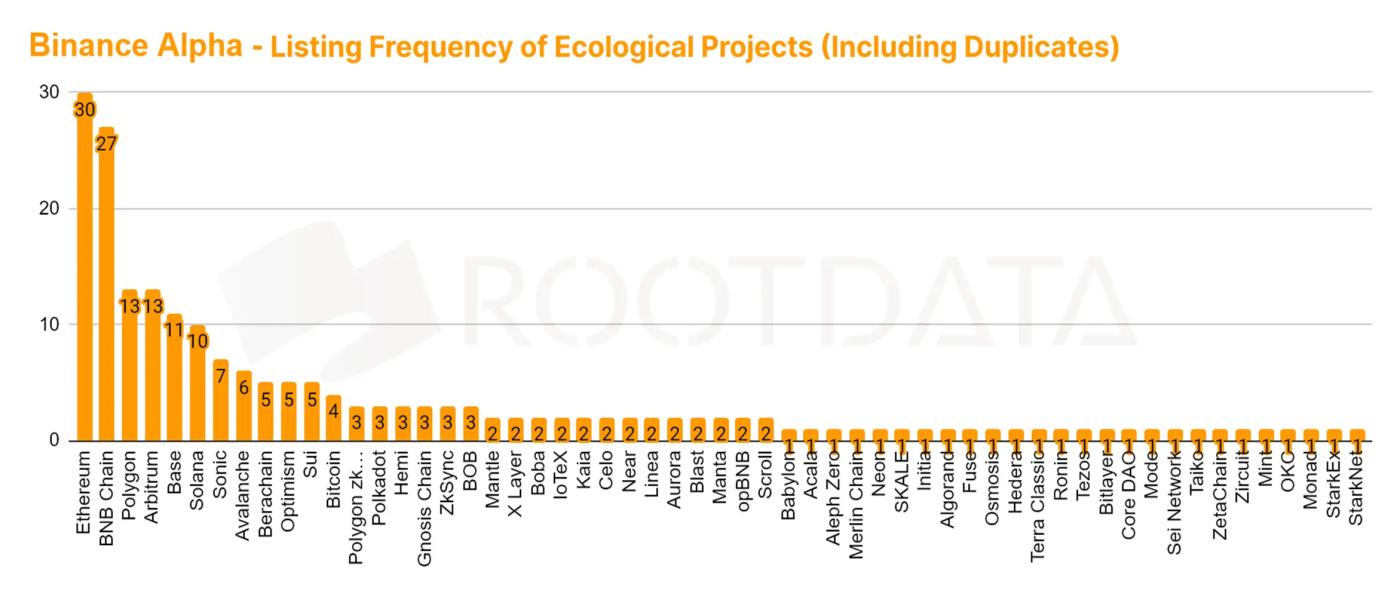
According to Rootdata financing data:
Among the tokens launched on Binance Alpha, 56.5% are projects that have never announced financing , with a total market value of $8.69 billion, while the total market value of projects that have received financing is only $6.23 billion.
Among all the projects, 30 support the Ethereum network, 27 support the BSC network , followed by Polygon, Arbitrum, Base and Solana.
This means that in addition to obtaining an exit plan by officially listing on Binance, founders should give priority to supporting mainstream networks such as Ethereum and BSC to increase their chances of being selected by Binance Alpha.
More importantly, the project’s marketing strategy should prioritize the support of Binance users and the community, which may mean that the necessary condition of obtaining endorsements from excellent institutions has gradually become a thing of the past for listing on Binance.
The “VC Curse” is still in effect, and less than 25% of projects have a history of financing and valuation and have excellent performance
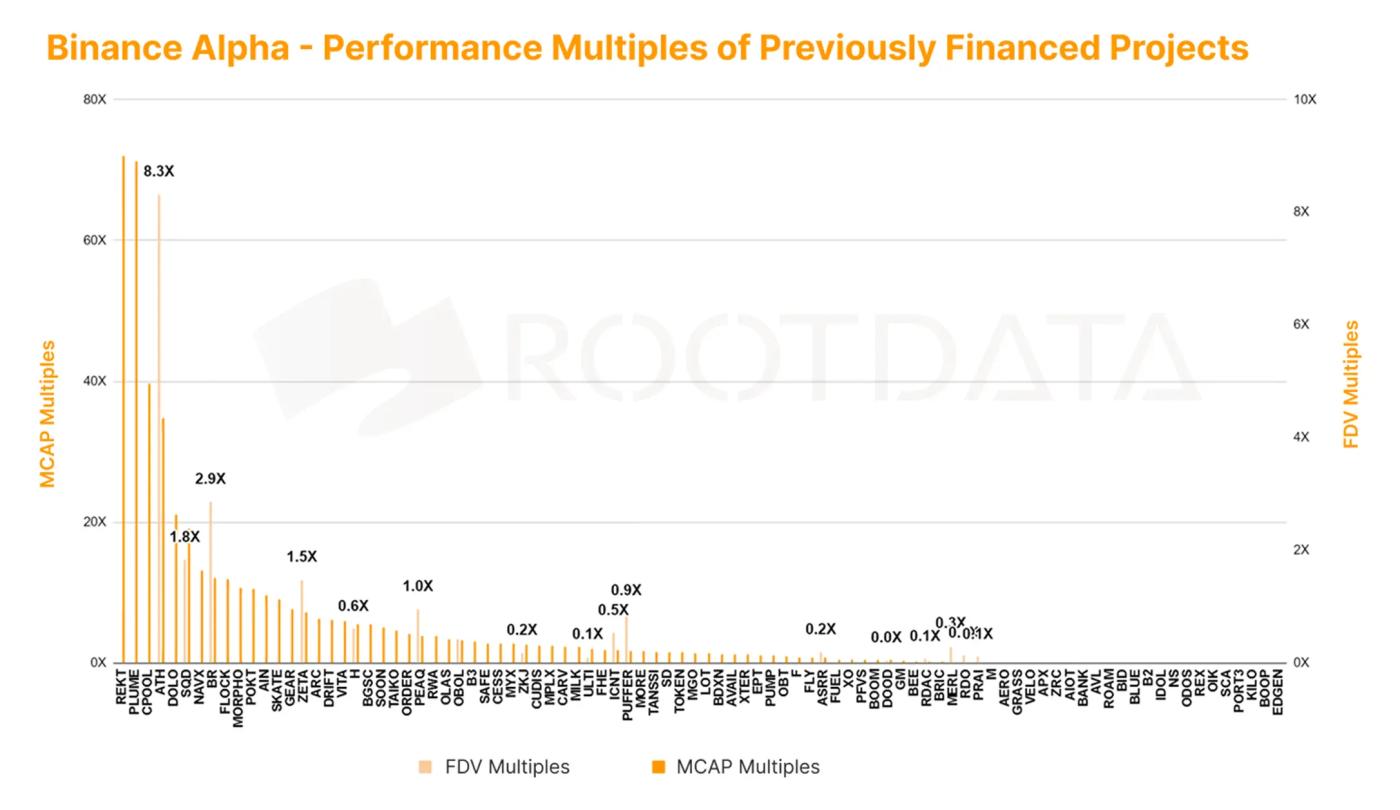
The “VC Curse” is still in effect for the following reasons:
- Lack of liquidity in the external crypto industry
- Retail investors' buying appetite is weak
- Institutional investment misallocates overvalued projects
- The encryption industry has entered a stage of maturity with technical bottlenecks
Insufficient innovation and the inability to organically integrate with the booming AI industry have resulted in the inability to introduce external spillover liquidity.
- MCAP ratio: calculated by dividing the financing valuation by the current market value. Among the projects with a financing history, the one that can maintain more than 10 times is 0. Based on the current performance, institutions expect it to be difficult to recover the cost.
- FDV ratio: calculated by dividing the financing valuation by the FDV current valuation, less than 25% of projects have a financing valuation history and excellent performance, and the failure rate is as high as 75%.
Stablecoins and RWA, the dawn of hope from Wall Street
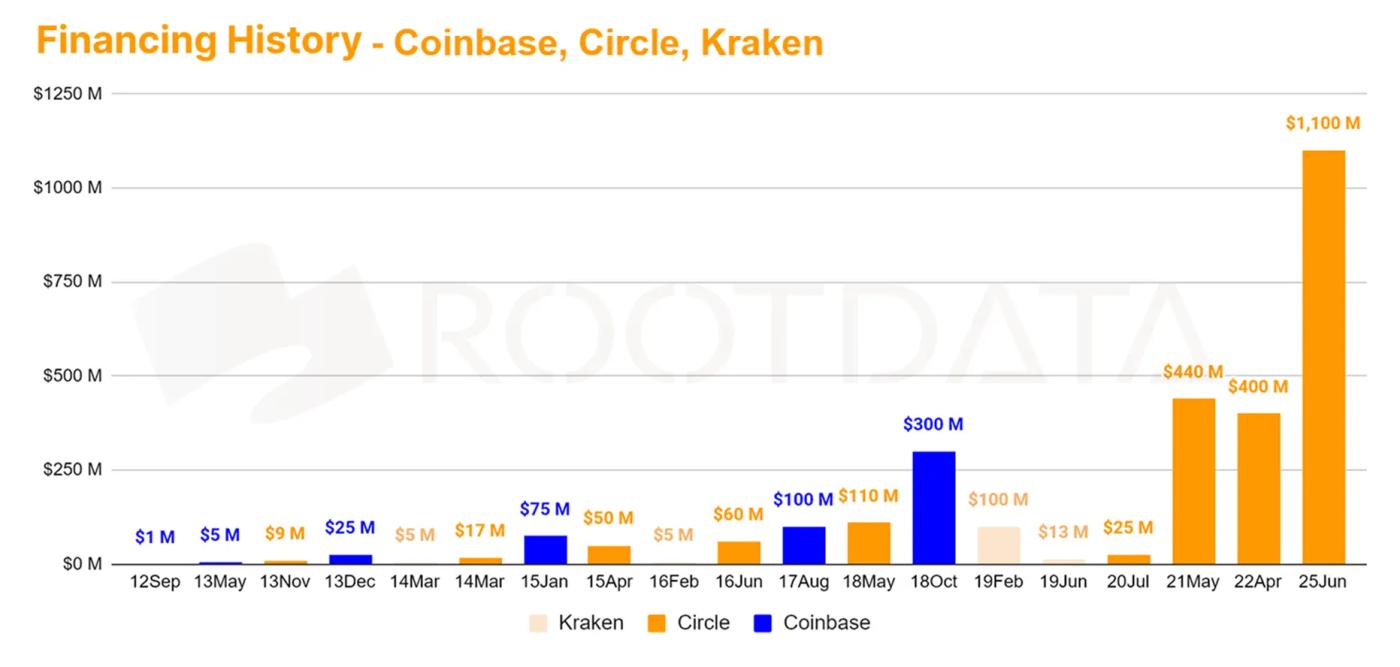
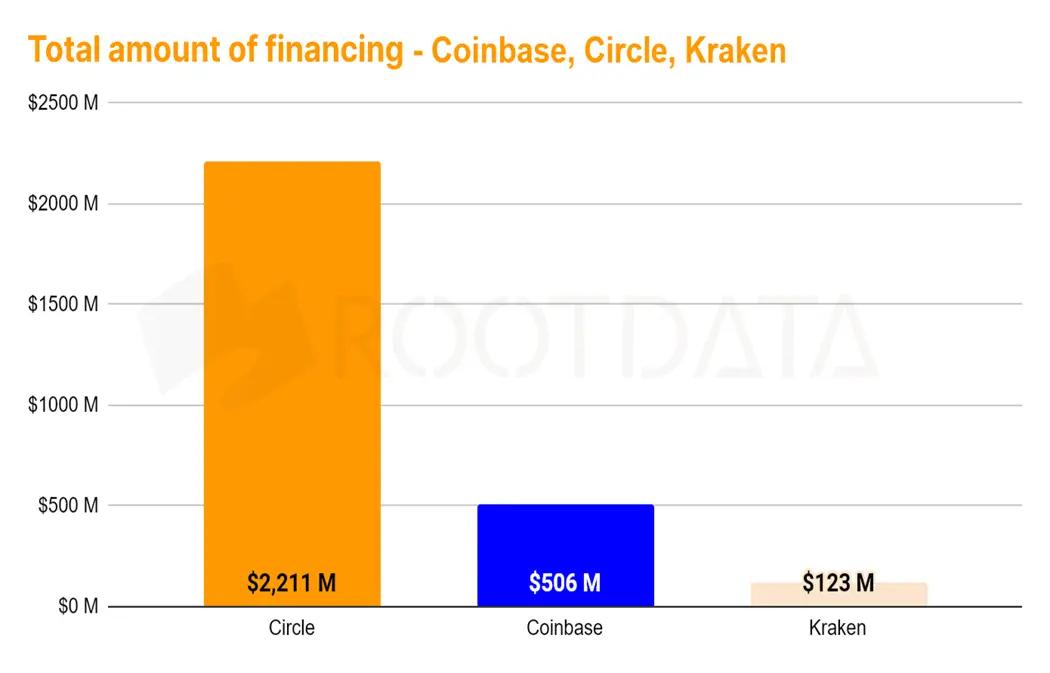
The market value of stablecoins increased from $226 billion to $244 billion in Q2, with a quarterly growth rate of 7.9%. Benefiting from the signing of the Stablecoin Regulatory Act and the "Big and Beautiful" Act, mandatory holding and national reserves will provide debt purchasing power for the US dollar, and the market value of stablecoins is expected to continue to grow. Therefore, holding stablecoins and related RWA income is expected to receive preferential policies such as national support and tax exemptions in the future.
Benefiting from the above favorable factors, Circle, the issuer of USDC that went public in Q2, became the first stablecoin concept stock in the Nasdaq cryptocurrency sector, in addition to BTC mining, cryptocurrency holdings, exchanges and other concepts, and became a money-making beast on Wall Street within a week of its listing.
Circle's astonishing valuation surge: According to Rootdata OTC data, before the IPO, Circle SPV was sold OTC at $36 per share (valued at $8.2 billion), while CRCL is currently priced at $204 per share. Therefore, after listing on Nasdaq, Circle's valuation rose to $46.6 billion, a 566.7% increase.
The valuation advantage of stablecoin concepts in the Nasdaq market over other cryptocurrency concepts
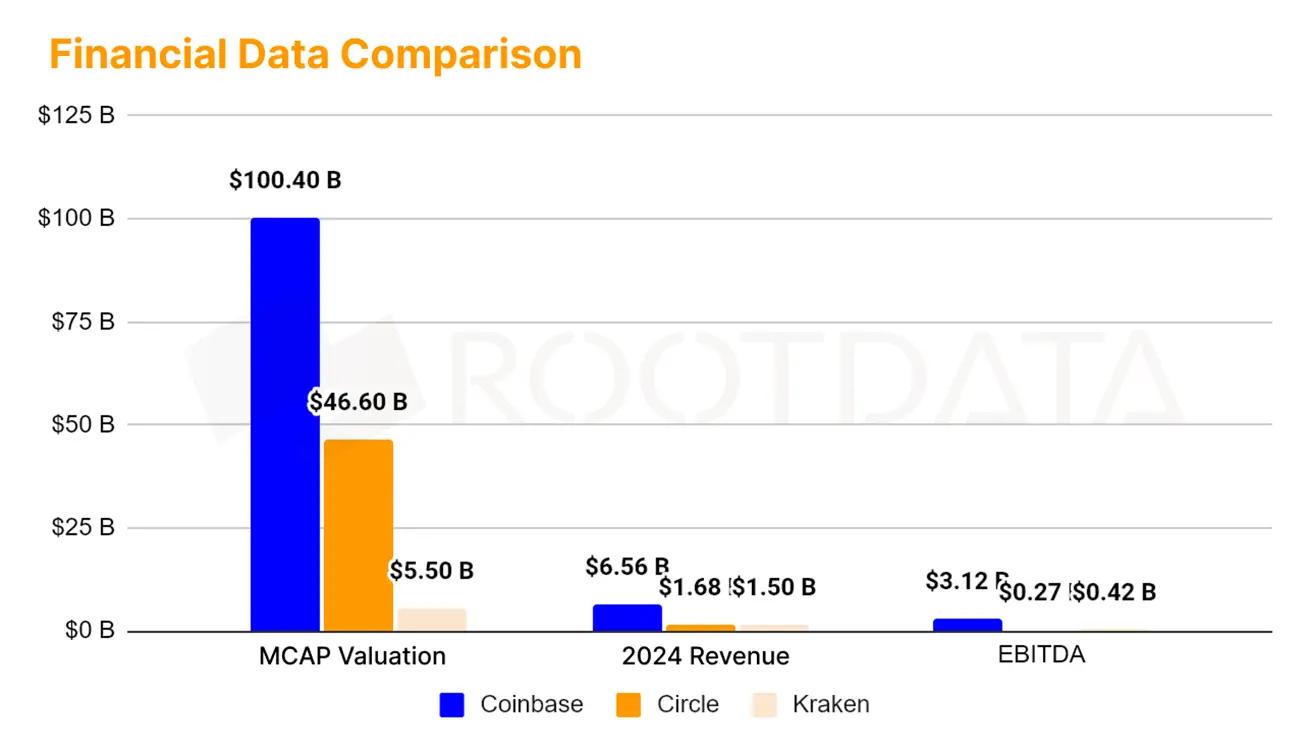
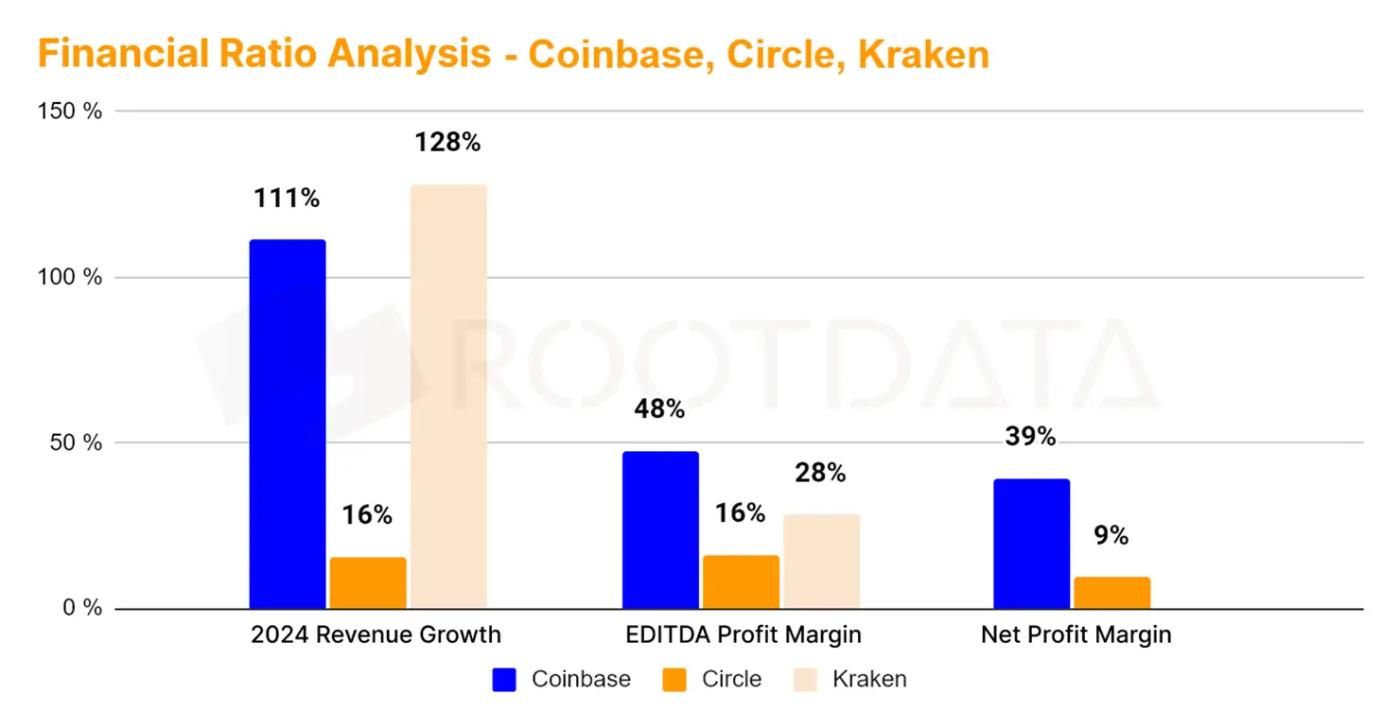
According to Rootdata OTC statistics, the most popular IPO project at present is the Kraken exchange concept stock. Kraken's Pre-IPO valuation analysis shows:
- Using the P/E method to compare Coinbase and Circle, there are 20 times and 8 times of room for growth respectively.
- Using revenue method, there is 4 times more room than Coinbase
- Kraken’s cost control, revenue growth, and profit margins are significantly higher than Circle’s
This indirectly reflects Wall Street's favor for stablecoins and RWAs, and also confirms the valuation advantage of the stablecoin concept over other cryptocurrency concepts in the Nasdaq market.
Circle is the project with the highest amount of financing among IPO projects, reaching US$2.2 billion. In comparison, Coinbase and Kraken only raised US$500 million and US$120 million respectively. The time rhythm of their large-scale financing in US stocks is 1-2 years.
M&A/Pre-IPO/IPO/Private Equity occupy the top four rounds with the highest financing amount


Under the influence of the Q2 trend, Rootdata data shows that hot money in the market is moving closer to US stock concepts. In the first half of the year, the top four rounds of financing were contracted by institutional activities (M&A/Pre-IPO/IPO/private placement) , which significantly exceeded the seed to A rounds of financing that were favored by crypto venture capital and intensively appeared in the DeFi and infrastructure fields.
The integration of upstream and downstream resources in the industry and the trend of backdoor listings have attracted the attention of crypto whale to Wall Street funds.
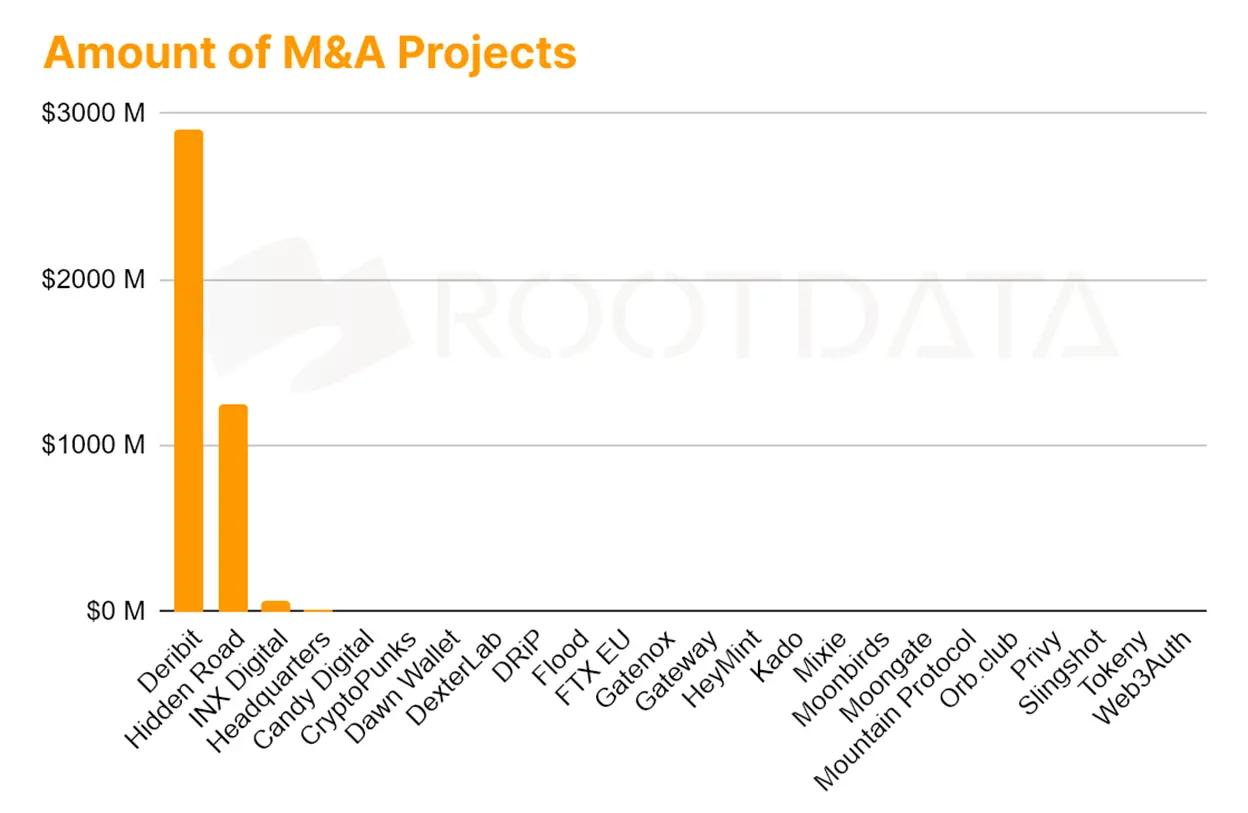
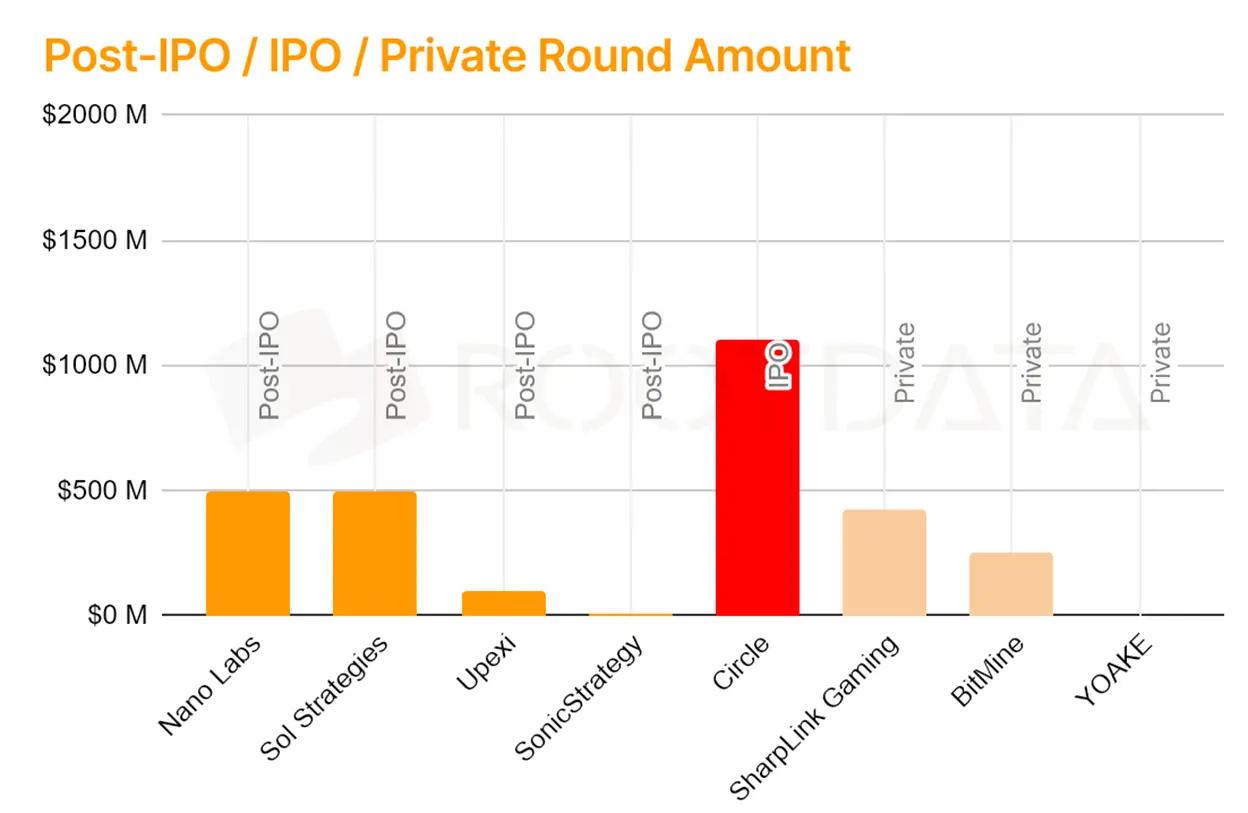
Key transactions of note include:
- Deribit, the leading options trading platform, was acquired by Coinbase, which also launched perpetual contract trading in the United States in compliance with regulations.
- Nano Labs Mining Concept
- Sol Strategies raises money for Solana bonds and SharpLink raises money for ETH bonds
This capital flow trend confirms the cyclical characteristics of the above-mentioned technical bottlenecks and maturity curves - the integration of upstream and downstream industry resources . At the same time, it also blew up the familiar wind of SPAC backdoor listing in 2021, triggering the crypto whale to be eager for Wall Street funds. In addition to thinking about how to increase cash flow income, entrepreneurs should also consider how to "cash out" in a timely manner.
The way out for grassroots cryptocurrencies: RWA or algorithmic stablecoins ?
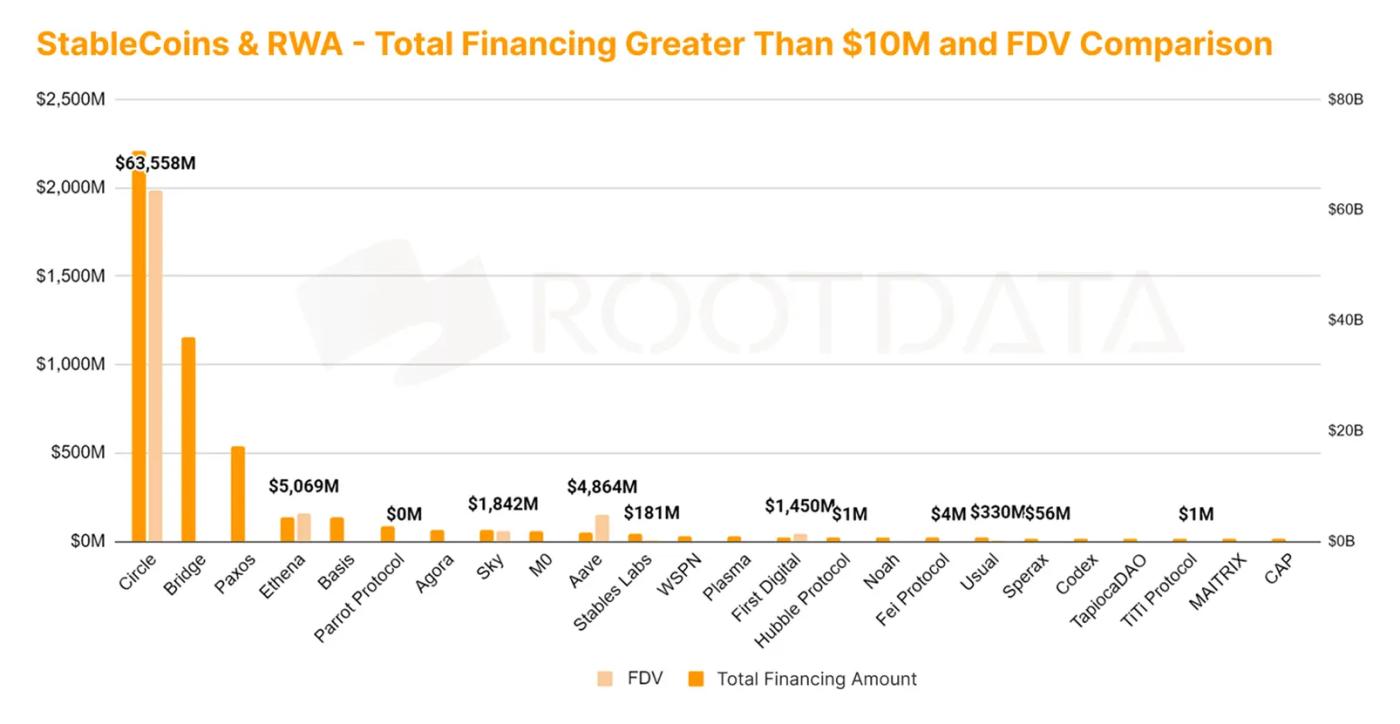
According to Roodata statistics, the current financing amounts of the stablecoin concepts of Circle are comparable to those of Bridge, Paxos and Ethena. Among them, RWA, one of the DeFi applications, and the algorithmic stablecoin are seriously underestimated compared to Circle, which is backed by Wall Street funds.
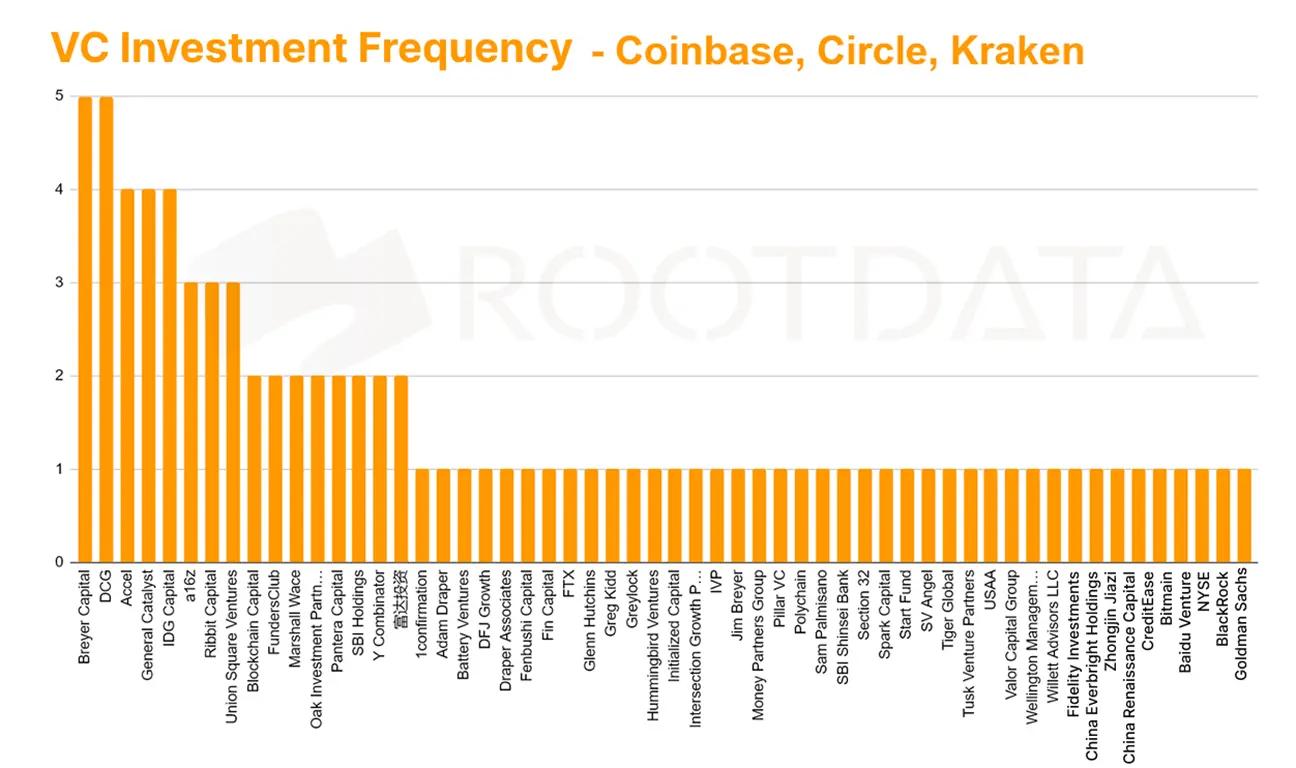
According to the above figure, the venture capital institutions that invested in Circle, Coinbase, and Kraken in the early stage and reinvested in them include Breyer, DCG, General Catalyst, IDG, a16z, Rabbit Capital, etc., which are at the top of the list. These VCs have become the biggest winners in this round of crypto-US concept stocks. The overflow of these risk-diversified funds is expected to diversify the investment risks to the crypto-native stablecoins and RWA concept coins related to the above.
View the PDF version of this report: Chinese | English
About RootData
RootData is a Web3 asset data platform dedicated to making Web3 investment easier. It has collected more than 16,000 projects, 10,000 investors, 13,000 people, and 8,800 financing rounds, and presents data in a highly visual and structured manner. It has become an essential data platform for more than 2 million Web3 users to discover early alpha projects and make investment decisions.
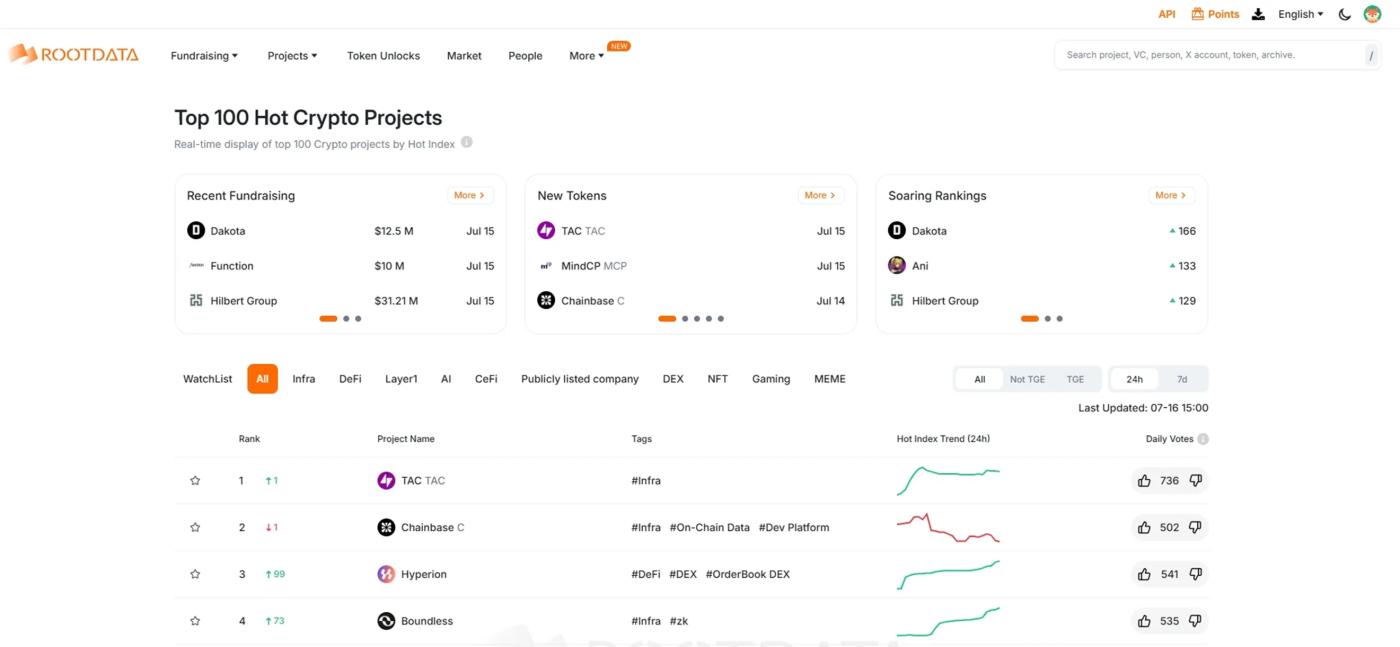
Disclaimer
This report is produced by RootData Research. The information or opinions expressed in this report do not constitute investment strategies or recommendations for anyone. The information, opinions and speculations contained in this report only reflect the judgment of RootData Research on the day of the release of this report. Past performance should not be used as a basis for future performance. At different times, RootData Research may issue reports that are inconsistent with the information, opinions and speculations contained in this report. RootData Research does not guarantee that the information contained in this report is kept up to date. Reliance on the information in this material is at the discretion of the reader. This material is for reference only.
This report is produced by RootData Research. The information or opinions expressed in this report do not constitute investment strategies or recommendations for anyone. The information, opinions and speculations contained in this report only reflect the judgment of RootData Research on the day of the release of this report. Past performance should not be used as a basis for future performance. on the information in this material is at the discretion of the reader. This material is for reference only.






